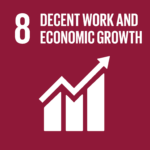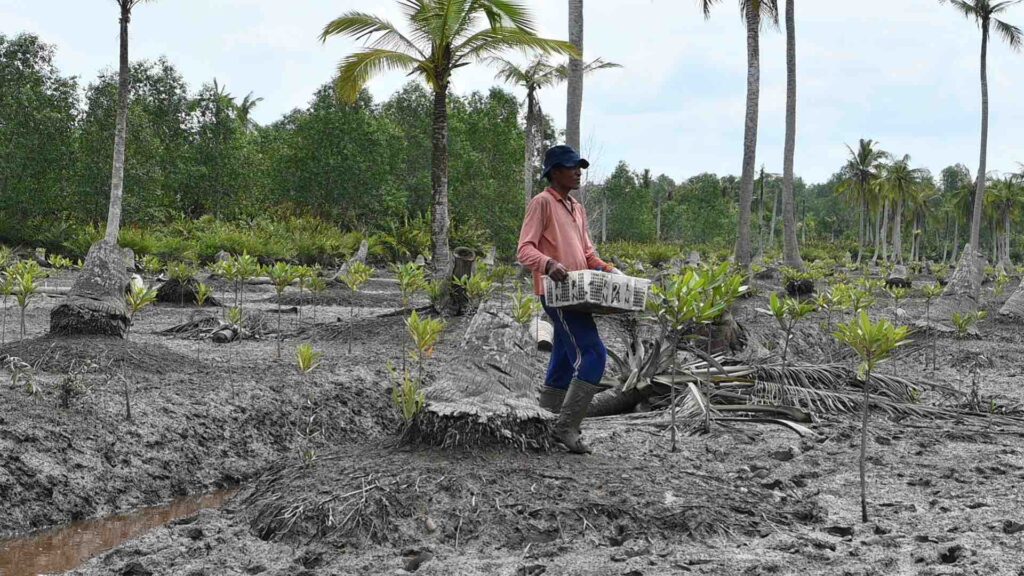Once-thriving coconut plantations, decimated by rising sea levels, are giving way to mangrove forests and a new way of life for local residents.
In the remote coastal region of Indragiri Hilir, Riau Province, Indonesia, a quiet revolution is taking place. Once-thriving coconut plantations, decimated by rising sea levels, are giving way to mangrove forests and a new way of life for local residents.
RELEVANT SUSTAINABLE GOALS



Andi Masrapi, 45, known locally as Rapi, embodies this transformation. His wooden stilt house in Parit 18, Sapat Village, now serves as both home and business hub. Where he once harvested tens of thousands of coconuts, Rapi now runs a small grocery store and acts as a collector for local fishermen’s catches.
“We’ve surrendered to fate,” Rapi says, reflecting on the loss of his coconut groves. “As they say, our fortune is determined by God.”
Hectares of plantation are being destroyed by Rising Sea levels
The decline of Indragiri Hilir’s coconut industry, once the largest in Indonesia, has been swift and devastating. Saltwater intrusion has killed vast swaths of coconut trees in less than a decade, leaving behind ghostly stands of dead trunks where lush groves once stood.
While many residents have abandoned Parit 18 for urban centers, Rapi and a small group have stayed, adapting to their changing environment. The flooded former plantations have become breeding grounds for mangroves, bringing with them a bounty of crabs, clams, fish, and shrimp.
This natural transformation has inspired a new initiative: the Blue Forests Program. Implemented by a consortium including the Blue Forests Foundation, Mitra Insani Foundation, and Sustainable Coastlines Foundation, with funding from UK AID-ICF, the program aims to protect and restore mangrove forests while supporting sustainable livelihoods for coastal communities.
In Parit 18, the program is rehabilitating 6.8 hectares of former coconut plantations into mangrove forests. Rapi has voluntarily offered his land for this effort, understanding the vital role mangroves play in supporting the local fishing economy.
“There’s no more yield from the coconut groves,” Rapi explains. “It’s better we use it for mangroves. So the crabs can also thrive there.”
The rehabilitation process, which began in June 2022, involves careful planning and community engagement. Local fishermen, coordinated by Rapi, are actively involved in the planting and monitoring of mangrove species chosen for their suitability to the area.
Early monitoring results show positive growth, particularly for Avicennia alba and Sonneratia caseolaris species. This success has become a learning opportunity for the community. Samsuri, a 28-year-old fisherman, notes, “I now understand which seedlings are superior and suitable for planting in our area.”
May the mangroves we plant grow well. So that crabs also become more abundant. It will be good for us fishermen to make a living.
Mala, Indragiri Hilir Regency Fisherwoman
The project also empowers women in the community. Mala, a 27-year-old fisherwoman participating in the rehabilitation, expresses hope for the future: “May the mangroves we plant grow well. So that crabs also become more abundant. It will be good for us fishermen to make a living.”
While the full success of the mangrove rehabilitation in Parit 18 is yet to be realized, a new understanding of the importance of mangroves for livelihoods is taking root among the community. As climate change impacts become increasingly tangible, the resilience of these coastal communities may well depend on their ability to adapt and nurture the emerging mangrove ecosystems.
Lead image courtesy of Wahyudin Opu/Blue Forests (Crab fishermen in Parit 18, Sapat Village, show off their catch.)
You may also be interested in :
Women in Indonesian Fisheries : An Under-Recognised Force in Economic Growth and Recovery




